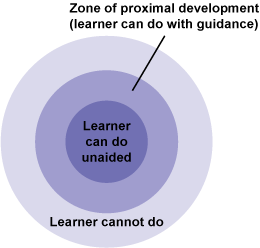6 The zone of proximal development (ZPD)
An important aspect of Vygotsky’s theory is the zone of proximal development (ZPD). The concept emphasises the social aspects of learning by recognising the role of a ‘teacher’ (in an official or unofficial capacity) for a learner to realise their full potential. His view was that language arises as a means of communication between a child and those around them, and that it is the social interaction that develops children’s learning and language; this places the teacher/caregiver in a very important role.
Contrary to the research dominant in the nineteenth century, Vygotsky argued that there is an optimal age for all learning and that for some topics, students might be either too young or too old to learn efficiently. Vygotsky also challenged the view that the brightest students continue to learn more than weaker students upon entering school. He makes the case that, in comparative terms, the learning of brighter students actually slows down when they enter school. On the basis of such evidence, Vygotsky introduces the concept of relative achievement, which emphasises the importance of assessing achievement in relation to the starting point. In relative terms, brighter students (measured in IQ terms) learn less and weaker students learn more. This, in turn, leads him to introduce the notion of ‘zone of proximal development’, which is a key concept in Vygotsky’s thinking. It relates to the differences between where the child/student currently is in terms of intellectual ability, and where they could be. The implications of this idea is that a child could gain a higher degree of learning by exploiting their learning potential. Key to Vygotsky’s thinking is also that this learning potential is best developed through interaction with an adult, an idea that is central to the sociocultural linguistic approach to learning adopted on this course.

